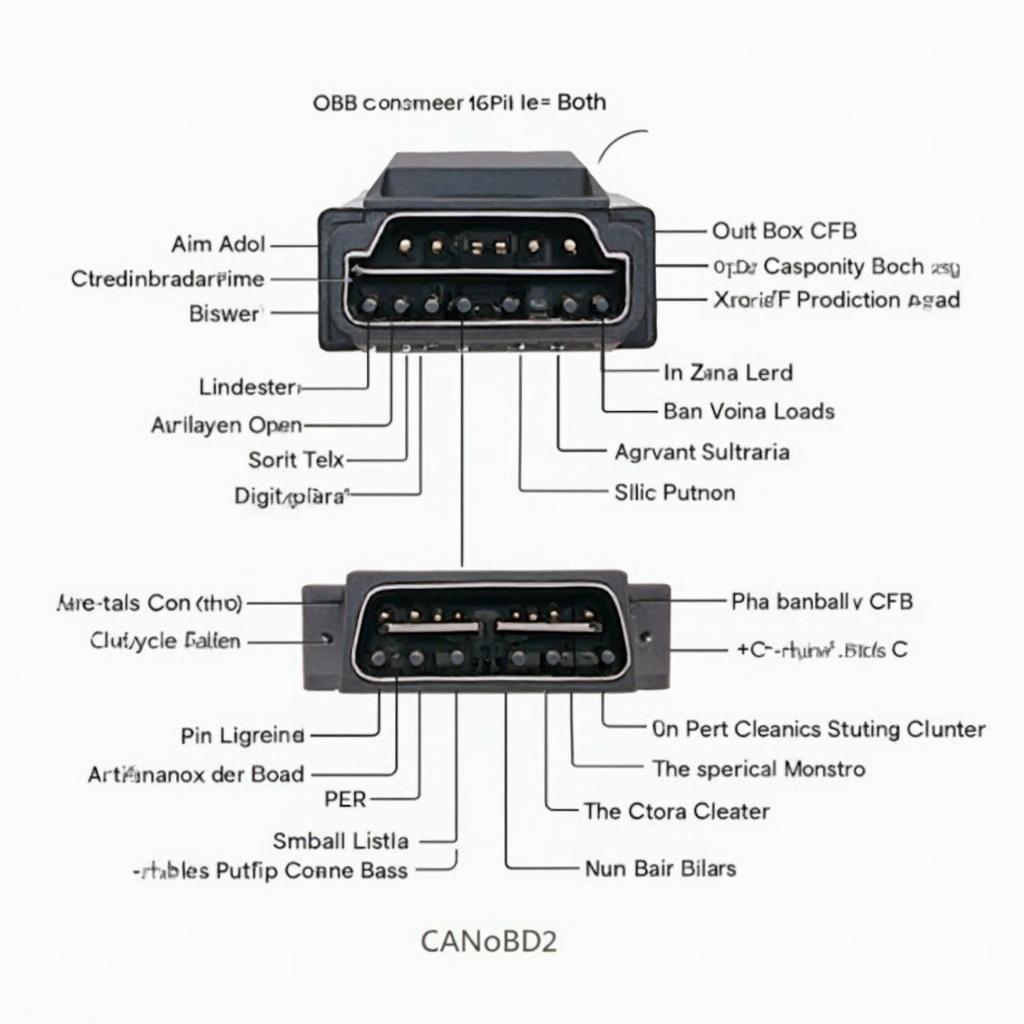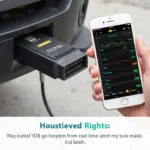OBD2 and CANOBD2 are terms often used interchangeably, leading to confusion. This article clarifies the distinctions between OBD2 and CANOBD2, helping you choose the right diagnostic tool for your needs. We’ll delve into the core functionalities, communication protocols, and compatibility aspects of each, empowering you to make informed decisions.
Decoding OBD2 and CANOBD2
OBD2, or On-Board Diagnostics II, is a standardized system that allows external devices to access a vehicle’s diagnostic data. It became mandatory in the US for model year 1996 gasoline vehicles and later for diesel vehicles. OBD2 utilizes various communication protocols, including ISO 9141-2, KWP2000, J1850 PWM, J1850 VPW, and CAN.
CANOBD2 refers specifically to vehicles using the Controller Area Network (CAN) protocol within the OBD2 framework. CAN is a more robust and faster communication protocol that allows for more data transmission and sophisticated diagnostics. Most vehicles manufactured after 2008 utilize CAN for OBD2 communication.
Key Differences: OBD2 vs. CANOBD2
The primary difference lies in the communication protocol. OBD2 is an umbrella term encompassing several protocols, while CANOBD2 specifically denotes the use of the CAN protocol within the OBD2 framework. This distinction impacts several aspects:
- Data Transfer Speed: CAN offers significantly faster data transfer rates compared to other OBD2 protocols. This translates to quicker diagnostics and more real-time data access.
- Complexity: CAN systems are more complex than other OBD2 protocols, requiring specialized diagnostic tools capable of decoding CAN messages.
- Diagnostic Capabilities: CANOBD2 allows for more in-depth diagnostics, providing access to a wider range of vehicle parameters and systems.
- Vehicle Compatibility: While OBD2 is standardized, the specific protocol used varies depending on the vehicle’s make, model, and year. CANOBD2 is predominant in newer vehicles.
Choosing the Right OBD2 Scanner: Does Protocol Matter?
Selecting the right OBD2 scanner depends largely on the vehicle you intend to diagnose. If you primarily work with newer vehicles (post-2008), a CANOBD2 compatible scanner is essential. However, for older vehicles, a scanner supporting multiple OBD2 protocols is necessary. Many modern scanners support all OBD2 protocols, including CAN, offering versatility and broader compatibility.
What if I use a CANOBD2 scanner on an older car?
If you attempt to use a CAN-only scanner on a vehicle that doesn’t use the CAN protocol, the scanner likely won’t communicate with the vehicle’s ECU. You’ll need a scanner that supports the specific protocol used by the vehicle.
Can I use a regular OBD2 scanner on a CANOBD2 car?
While some older OBD2 scanners might be able to read basic fault codes on a CANOBD2 car, they might not have access to all the available data or advanced diagnostic functionalities.
Benefits of Using a CANOBD2 Scanner
- Faster Diagnostics: Retrieve diagnostic information quickly, reducing troubleshooting time.
- Enhanced Data Access: Access a broader range of vehicle parameters, enabling more comprehensive analysis.
- Advanced Diagnostics: Perform more sophisticated diagnostic functions, such as bi-directional control and live data streaming.
“CANOBD2 has revolutionized vehicle diagnostics. The speed and depth of information it provides are invaluable for technicians,” says Michael Stevens, Senior Automotive Diagnostic Engineer at AutoTech Solutions.
Future of OBD2 and CANOBD2
As vehicle technology advances, the role of CAN and other high-speed communication protocols within the OBD2 framework will continue to grow. Future developments are likely to focus on enhanced data security, wireless communication, and integration with cloud-based diagnostic platforms.
“The future of diagnostics lies in leveraging the power of data. CANOBD2 provides the foundation for this future, enabling deeper insights into vehicle performance and predictive maintenance,” adds Dr. Emily Carter, Lead Researcher at Automotive Research Institute.
Conclusion
Understanding the difference between OBD2 and CANOBD2 is crucial for anyone working with vehicle diagnostics. While OBD2 is the overarching standard, CANOBD2 signifies the utilization of the CAN protocol, offering faster data transfer and more comprehensive diagnostic capabilities. Choosing the right scanner depends on the specific vehicles you work with, emphasizing the importance of understanding these key distinctions. Investing in a quality OBD2 scanner that supports all relevant protocols, including CAN, is a wise decision for any professional or enthusiast seeking accurate and efficient vehicle diagnostics.
FAQ
-
What is the main difference between OBD2 and CANOBD2? The main difference lies in the communication protocol. OBD2 is a general term, while CANOBD2 specifically uses the CAN protocol.
-
Are all OBD2 scanners compatible with CANOBD2? No, not all OBD2 scanners are CANOBD2 compatible. Ensure your scanner specifically supports CAN.
-
Is CANOBD2 faster than other OBD2 protocols? Yes, CAN offers significantly faster data transfer rates compared to other OBD2 protocols.
-
Which protocol is used in my car? The protocol used depends on your car’s make, model and year. Check your owner’s manual or use an online OBD2 protocol lookup tool.
-
Do I need a special scanner for CANOBD2? Yes, you need a scanner that specifically supports the CAN protocol for CANOBD2 vehicles.
-
What are the benefits of using a CANOBD2 scanner? Benefits include faster diagnostics, enhanced data access, and more advanced diagnostic functions.
-
What is the future of OBD2 and CANOBD2? The future likely involves enhanced data security, wireless communication, and cloud-based diagnostic platforms.
Common Scenarios and Questions
- Scenario: Check engine light is on in a 2015 car. Question: What type of scanner do I need? Answer: A CANOBD2 compatible scanner.
- Scenario: Troubleshooting intermittent issues in a 1998 car. Question: Will a CANOBD2 scanner work? Answer: Likely not. You’ll need a scanner supporting multiple protocols.
Related Articles and Further Reading
- OBD2 Codes Explained
- How to Choose the Right OBD2 Scanner
- Understanding Vehicle Diagnostic Protocols
Need support? Contact us via WhatsApp: +1(641)206-8880, Email: [email protected] or visit us at 789 Elm Street, San Francisco, CA 94102, USA. Our customer support team is available 24/7.

